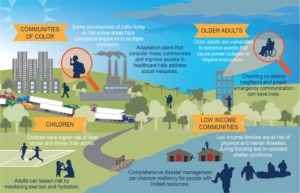Climate Legacies and Climate Justice for All – Climate Safe Neighborhoods

In most American cities and towns, there is a history behind a neighborhood’s structure and design and, by extension, residents’ exposure to climate-related heat, flooding, and extreme weather.
Highways, industrial fields, chemical factories, and garbage dumps are often found in historically segregated communities. The same communities often lack tree canopy and green spaces, compounding the impact of the climate crisis.
The climate crisis threatens to make our communities hotter and wetter than they have ever been before, but not all neighborhoods within a city will suffer the social, health, and financial consequences equally. Many communities subject to government-sanctioned racist housing practices in the 1930s and 1940s are most at risk today for experiencing extreme heat and flooding.
In this Let’s Talk Climate we are talking with Groundwork USA’s Cate Mingoya to explore the relationship between historical redlining and the current and predicted impacts of climate change, and how communities are forging the path toward environmental & climate justice for all through the Climate Safe Neighborhoods partnership.
Watch the full recording HERE
